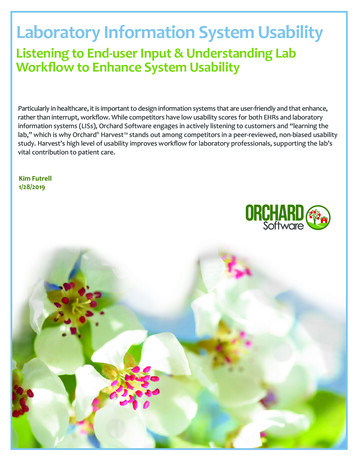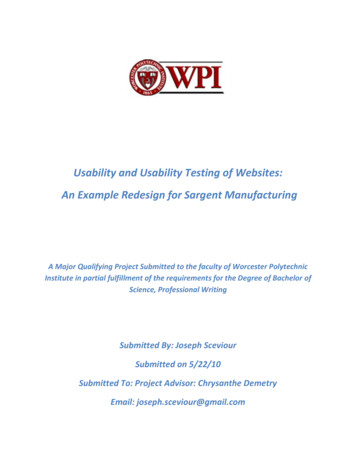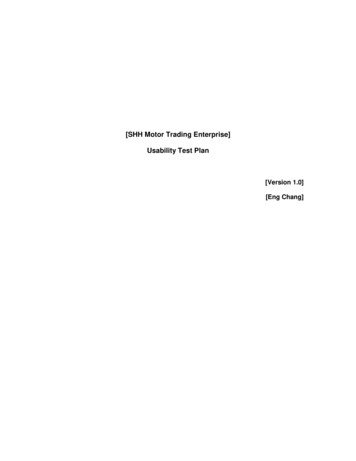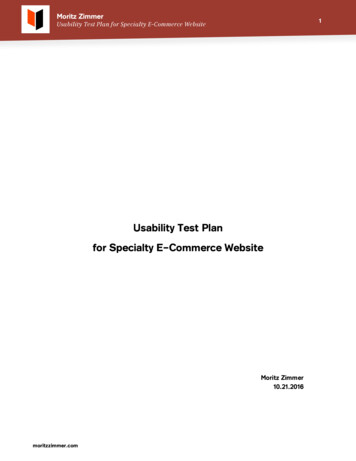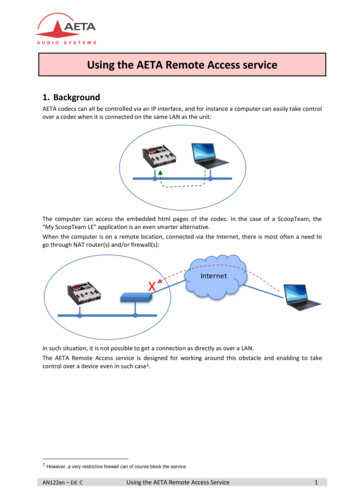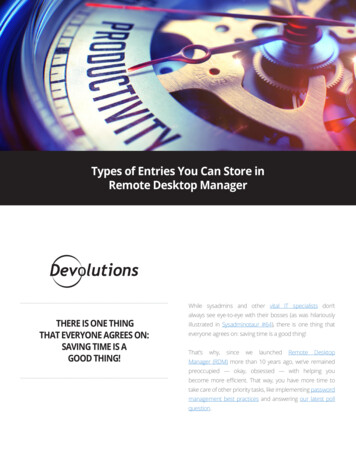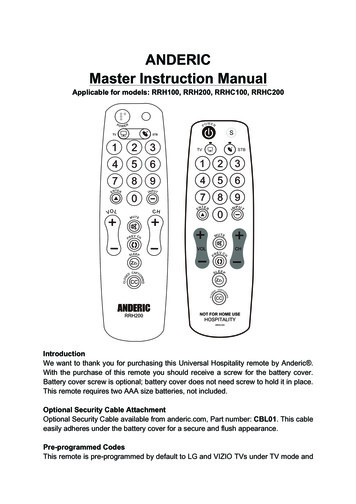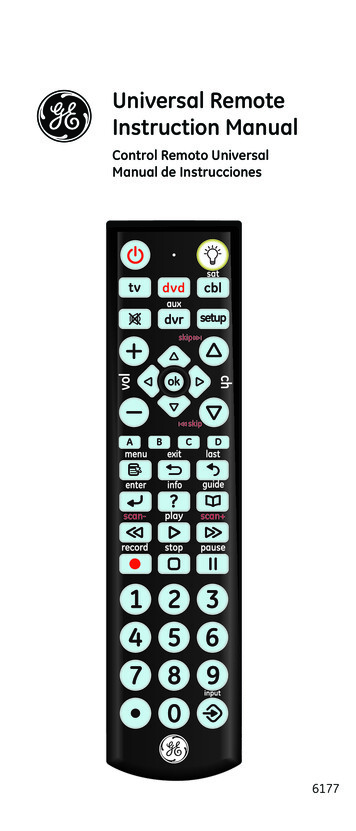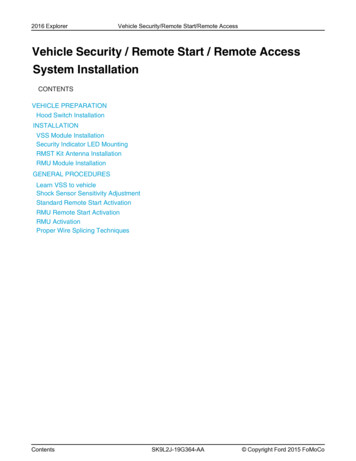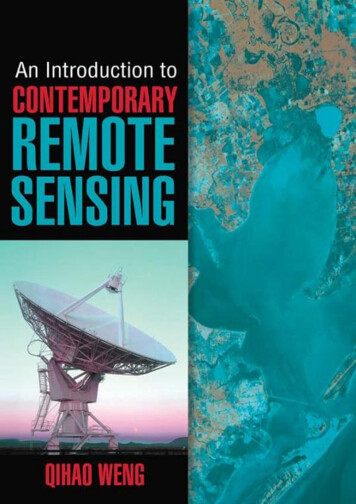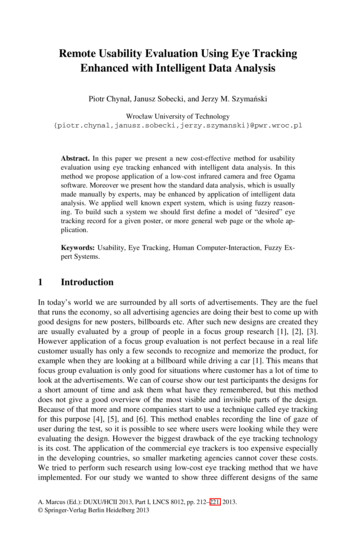
Transcription
Remote Usability Evaluation Using Eye TrackingEnhanced with Intelligent Data AnalysisPiotr Chynał, Janusz Sobecki, and Jerzy M. SzymańskiWrocław University of nski}@pwr.wroc.plAbstract. In this paper we present a new cost-effective method for usabilityevaluation using eye tracking enhanced with intelligent data analysis. In thismethod we propose application of a low-cost infrared camera and free Ogamasoftware. Moreover we present how the standard data analysis, which is usuallymade manually by experts, may be enhanced by application of intelligent dataanalysis. We applied well known expert system, which is using fuzzy reasoning. To build such a system we should first define a model of “desired” eyetracking record for a given poster, or more general web page or the whole application.Keywords: Usability, Eye Tracking, Human Computer-Interaction, Fuzzy Expert Systems.1IntroductionIn today’s world we are surrounded by all sorts of advertisements. They are the fuelthat runs the economy, so all advertising agencies are doing their best to come up withgood designs for new posters, billboards etc. After such new designs are created theyare usually evaluated by a group of people in a focus group research [1], [2], [3].However application of a focus group evaluation is not perfect because in a real lifecustomer usually has only a few seconds to recognize and memorize the product, forexample when they are looking at a billboard while driving a car [1]. This means thatfocus group evaluation is only good for situations where customer has a lot of time tolook at the advertisements. We can of course show our test participants the designs fora short amount of time and ask them what have they remembered, but this methoddoes not give a good overview of the most visible and invisible parts of the design.Because of that more and more companies start to use a technique called eye trackingfor this purpose [4], [5], and [6]. This method enables recording the line of gaze ofuser during the test, so it is possible to see where users were looking while they wereevaluating the design. However the biggest drawback of the eye tracking technologyis its cost. The application of the commercial eye trackers is too expensive especiallyin the developing countries, so smaller marketing agencies cannot cover these costs.We tried to perform such research using low-cost eye tracking method that we haveimplemented. For our study we wanted to show three different designs of the sameA. Marcus (Ed.): DUXU/HCII 2013, Part I, LNCS 8012, pp. 212–221, 2013. Springer-Verlag Berlin Heidelberg 2013
Remote Usability Evaluation Using Eye Tracking213product to the testers, just for a few seconds, to record, using eye tracking equipment,which parts of those designs testers were able to notice. Such case study would alsoshow can our low-cost eye tracking method provide valuable results for visual mediaevaluation.The construction of this paper is following. In the following section we present thetools we have applied in the usability evaluation, then we describe the experiment. Inthe section 4 we present the results of the eye tracking experiments. In the section 5we describe the application of the fuzzy expert systems for the gaze tracking dataanalysis and finally in section 6 we present the summary and the future work.2Tools Used in the ExperimentHaving a lot of experience with performing low-cost eye tracking using web cam [7],[8] we used the similar method with new applications. In this research we performedeye tracking with and infrared A4-TECH PK-333E camera1, and ITU GazeTracker2combined with Ogama3 software.A4-TECH PK-333E camera is a very cheap camera, equipped with seven LEDs soit enables night vision. It has high image quality and works without delay at 640x480pixels video resolution.ITU GazeTracker [9], [10] is an open-source application that enables gazetrackingusing an infrared camera. It supports two methods of operating – pupil tracking andglint tracking. We need to obtain a clear image of the eye in order to perform effectiveeye tracking. Both methods use corneal reflection created by infrared light sources.Ogama software allows recording and analyzing eye and mouse-tracking data fromslideshow eye tracking experiments. Ogama is a freeware and open-source project.Its main features include database-driven pre-processing and filtering of gaze andmouse data, the creation of attention maps, areas of interest definition, saliency calculation and many more. Nearly any eye tracking and/or presentation soft- and hardwarerecordings in ASCII format can be imported. Direct recording is possible with commercial tracking such as Tobii and it also enables recording from open-source applications like the ITU GazeTracker.To perform recording of the gaze or mouse data in Ogama we must create a slideshow at first. It is done in the Slide Design Module. We can place different types ofmedia on those slides such as images, text and flash animations.After creating the slideshow we can proceed to the recording module in which wesetup the participants’ data. After that we can calibrate the camera with ITU GazeTracker and launch the slideshow and the application gathers the eye tracking data.After the test we can visualize these data. The visualization module can calculateGaussian distributions of the fixation data and overlay it on the original stimulus image, so that we can see a landscape of seen and unseen locations on the stimulus. Wecan choose the subjects to include in the calculation and whether the calculation1www.a4tech.com/product.asp?cid 77&scid 160&id 2
214P. Chynał, J. Sobecki, and J.M. Szymańskishould be based only on the first or all fixations. Moreover Ogama allows to createAreas of Interest. Using this feature we can draw shapes on our slides and create areasthat are most important to us. Using this option we can see the number of fixationsand their total duration time, for one or many participants, in the given area of theposter.The last tool that we used was Precision test. We used this application to comparethe precision of our eyetracking solution with the previous methods and a commercialASL eye tracker [7].3The Eye Tracking ExperimentAt first we needed to get several different designs for the same product. We decidedto find some posters regarding social campaign instead of particular products, so wewould not advertise any products. We decided to go with three posters of Polish“Speed kills” campaign – “Prędkość zabija”4. They all have the same structure. Themain element is a picture of a particular situation. On the right site we have a sloganregarding the situation in the picture with reference to fast driving. At the bottom ofeach poster there is the main slogan and information about the campaign. All designsare showed in figure 1.Fig. 1. Poster designs4www.predkosczabija.pl
Remote Usability Evaluation Using Eye Tracking215The first poster shows a lady which is in a hurry and the slogan says “Sometimesyou race against time?”. Second design is a man holding a young girl, probably hisdaughter, while going on a roundabout. The slogan says “Do you like spinning fast?”.The third design shows a couple lying in the bed and the slogan which may be translated as “Are you Speedy Gonzales?”The second step was to determine the areas in which we would expect the participants’ gaze to spend the most time. Poster designers want to achieve specific goals bythe means of visual patterns. The way in which viewers perceive posters, read andthink about them depends on many factors. There are several general psychologicalrules of visual perception and many studies about text, web pages and digital bannerscontents visibility such as[11], [12], [13] were done. The usage of eyetracking in advertisements industry is well known [14], for example there is the rule of F-shapedpattern of gaze lanes made by web pages viewers [15]. In our experiment designersexpectations about message transferred by a poster are more important than generalprinciples. We have taken this presumption, as in the case of posters, it is important toconvey specific information, in expected way. This is the basis for determining thereal usefulness of the poster in achieving the assumed information functions.Based on campaign materials we have elaborated sets of data, for each poster, including messages that they want to pass, so we were able to define essential areas,connected with corresponding message, that apply for all examined posters. Generalstructure of examined posters is as shown in figure 2, where 1 - area showing peoplein strange situations, 2- short text area, 3 - slogan to remember, 4 - contact andreference for details.Fig. 2. Essential areas of interest for our postersFor this experiment we have taken a group of 20 people. The group consisted of 10male and 10 female participants. They were all in a group age from 20 to 28 years old.Young people were the target group for this campaign because they cause the accidents according to the authors of “Prędkość zabija” (“Speed kills”) campaign.For the first part of the research we have taken all the participants individually infront of a computer and set them up with our eyetracking gear. After calibrating theITU GazeTracker application we ran the precision test application and we have recorded the results of it. Because of the rather poor optics in our camera we needed to
216P. Chynał, J. Sobecki, and J.M. Szymańskimove it very close to the eye of the participant so we used a tripod. First thing that wehave noticed was that the correct set up of the elements of the eye was very easy andvery fast. ITU GazeTracker was automatically finding the pupil with just a few adjustments to the light and other parameters. We did not need to repeat the calibrationprocess for the most of the participants because after the correct eye set up, the calibration had very good results most of the time. After that we have shown the participants each of the designs (in random order for each participant) for 4 seconds usingOgama software, and asked them to browse it as they would normally do with anadvertisement. It is a time that user has to recognize and memorize the advertisementmessage that is placed on a billboard, bus or another object which makes it impossibleto look at this ad for a longer time. During this test we recorded the eye tracking datafor each participant in Ogama software. The whole process of performing such testsin Ogama was very easy and intuitive and we managed to complete the whole experiment without any problems.4Results of the Eye Tracking Experiment and Their analysisAt first we present the results from eye tracking study. We obtained three heat mapsfor each participant. We combined all those heat maps into one to show overall heatmap for each design for all participants. Those maps are shown in figure 3. The“warmer” the color the more time users gaze spend in the particular area. The Gaussian kernel size was set to 333 for best visibility of the results.Fig. 3. Eye tracking heat maps for each design
Remote Usability Evaluation Using Eye Tracking217In a short interview after the test each participant said that the red slogan is visible,but the lower part of the poster with a body bag and white slogan is not visible at alland the main slogan “Speed kills” should be at the top of the poster, maybe also in redcolor. Furthermore participants suggested that the picture should represent an accidentor something more drastic to have an impact on people.As for the precision test, the average precision for all participants was 81,25 pixels.Precision test, which we have conducted in our previous research, on ASL Eyetrackerand Logitech Quick Pro Webcam combined with Opengazer5 gave average precision47,65 pixels and 122,67 pixels accordingly [7]. Moreover calibration process usingITU GazeTracker was a lot easier and faster than while using both previously usedeyetracking solutions.Using Ogama software we were also able to determine the number of fixations andthe total fixation time for our areas of interest, as shown on figure 4.Fig. 4. Total fixation time for every participant in every area for the third designFirst of all we will look at the generated heat maps. For picture 1 it is clearly visible that the good looking woman has overshadowed the slogans, so with such designit would be hard to get the overall idea what this poster represents in just a fewseconds. The second heatmap shows that the main points of focus were the faces, butparticipants also noticed the red slogan and the white sign, so they had some ideawhat this poster represents. The third heatmap shows that participants looked at theman for the most time, and they also noticed the lady, red slogan and the white signalong with the zipper.Those heatmaps show that the lower parts of the pictures were not visible to theparticipants. The most important slogans and web address were completely invisible.First design was interesting for male participants because of the good lookingwoman. However this was in overall the worst design mainly because of the situation,which did not suggest that this is a poster for anti fast driving campaign. Participantsalso pointed out the bad coloring and the fact that the woman in the picture draws toomuch gazer/
218P. Chynał, J. Sobecki, and J.M. SzymańskiSecond design was the most popular mainly because of the dynamics showed onthis picture and also because it contained a scared child. Participants also liked theidea of the presented situation and the expressions on the faces of the father anddaughter. The visual value of the picture was also the best in this poster.The views on the third design were divided. Some participants insisted that thesexual subtext is a good thing that brings more attention to this design, while othersinsisted that this is a bit too vulgar and does not fit this campaign.Generally all posters were rated poorly by the participants. First one and the thirdone should be used for advertisements of some other products and not for anti fastdriving campaign. Second design was closest to what people expected, some dynamicand extreme situations showing the dangers of fast driving.5Applying the Intelligent Data AnalysisIn our experiments only 20 participants took part, however for more reliable researchalso more participants is needed. But as a consequence we obtain more data for analysis, which in turn may be quite difficult. We propose to apply well known fuzzyinference systems [16] in usability verification based on gaze tracking data. Fuzzyinference systems are application of fuzzy logic and fuzzy set theory proposed byLofti Zadeh in 1965. They are used to carry out very different tasks such as classification, diagnosis, process control or decision support, however they were also successfully applied in recommender systems [17].The Mumdani model Of Fuzzy Rule Based System (FRBS) a is shown in Fig. 5, inthis model the particular input characteristics is first mapped to the input membershipfunctions (fuzzification), which then is mapped to rules that are mapped into a set ofoutput characteristics and consequently to output membership function, which finallyis mapped to a single-valued output associated with the decision (defuzzification).Fig. 5. Mamdani model of FRBS [18]In our case we can select the following attributes concerning both the experimentparticipants’ description such as: age, gender, education, place of living. The valuesof these attributes were used as the input to determine the membership function valuesof linguistic variables [16]. All the membership functions applied in the system havethe trapezoid shape. The membership function values are defined as follows:
Remote Usability Evaluation Using Eye Tracking 1 x a1 b aμtrapezoid ( x) a1 x1 2 a2 b2 0, x [b1 , b2 ], x [a1 , b1 ), x (ba , a2 ), otherwise219(1)For example for variable x representing the participants’ gaze time (in seconds) beingshort, we have the following values of a1 2, b1 4, b2 6, a2 8.The attributes were used to construct fuzzy inference rules that for some assumptions expressed in so called linguistic values (eg. short time) assign conclusions concerning usability also expressed in the linguistic values. Depending on the complexityof the poster (number of the different regions) and the differences among the participants the system the number of the inference rules may vary from about 20 to over 60in the following form:If the age of the participant is medium and the gaze time at region 1 is long and thegaze time at the region 4 is short then the usability of the design is high.Each rule has associated confidence factor (cf [0,1]) given by the expert, which expresses his or her confidence in the particular rule. The cf multiplies the membershipfunction value of the outcome of the rule and by default this factor is set to 1.0.The defuzzification process is based on a very simple method called Mean ofMaximum (MOM) [16], which takes the mean value of the set with maximum membership grade. According to the fuzzy inference system we determine values thatrepresent the usability of the particular design, for the particular experiment participant, particular group of participants, the all the participants or select the best designaccording to the highest usability value.6Summary and Future WorkIn our experiment we have shown that this low-cost eye tracking method can be usedto perform a professional visual media evaluation and can be an additional tool tostandard techniques such as focus group research. ITU GazeTracker combined withinfrared camera provides descent eye tracking precision in comparison to commercialASL eyetracker. Furthermore this method provides better precision than previousmethods that we have developed earlier and presented in works [7] and [8]. Also thesetting up and the calibration process are easier and faster with this method comparingwith the previous one. As for the Ogama software it provides a very efficient testingenvironment for eye tracking. It is easy to set up a slideshow and the camera with eyetracking. Generated heatmaps look very professionally and an option for generatingheatmap based on the data from many participants is a very useful addition. The datagained from the areas of interest allowed us to perform the second part of our analysis
220P. Chynał, J. Sobecki, and J.M. Szymański– intelligent analysis of the eye tracking data. Using eye tracking allowed us to precisely determine which areas of the design were visible and which were invisible tothe participants in the first four seconds of their encounter with given media. It was asimulation of a real life situation in which recipients view a poster or a billboard justfor a few seconds, and its design should give all the necessary information in thisshort time. Eye tracking allows evaluating any visual media this way. It gives moreempirical information about the design than the discussion with participants of thefocus group.We have also presented how we can enhance the process of gaze tracking dataanalysis by application of fuzzy reasoning. The most important advantage of this method (besides low cost of eye tracking device) is that it may be used to analyze thedata gathered for single user, several users or even hundreds of users, which will givethe statistical significance. However one of the drawbacks of this method is necessityof definition or redefinition of set of rules for the different experiments. This problemmay be solved by application of determining fuzzy rules out of experimental data[19].This method that we presented can be used not only in evaluating posters, but alsoin many other types of media and also in website usability testing. Its precision wasnot as good as the precision of a commercial eyetracker, but for smaller companies itis a very good alternative for such tests.Acknowledgement. The research was partially supported by Grant no. N N519444939 funded by Polish Ministry of Science and Higher Education (2010-2013)and the European Commission under the 7th Framework Programme, Coordinationand Support Action, Grant Agreement Number 316097, ENGINE - Europeanresearch centre of Network intelliGence for INnovation 1. Burke, R.R., Rangaswamy, A., Sunil, G.: Rethinking Marketing Research in the DigitalWorld. eBusiness Researcher Center Working Paper 01, 13 (1999)2. Krueger, R.A., Casey, M.A.: Focus groups: A practical guide for applied research,pp. 107–113. Sage, Thousand Oaks (1999)3. Moyle, K.: Focus groups in educational research: using ICT to assist in meaningful datacollection. MOY06634, 1–3 (2006)4. Duchowski, A.T.: A Breadth-First Survey of Eye Tracking ntent/34/4/455.full.pdf5. Duchowski, A.T.: Eye tracking methodology: Theory and practice, pp. 205–300. SpringerVerlag Ltd., London (2003)6. Goldberg, H.J., Wichansky, A.M.: Eye tracking in usability evaluation: A practitioner’sguide. Elsevier, Amsterdam (2003)7. Chynał, P., Sobecki, J.: Comparison and analysis of the eye pointing methods and applications. In: Pan, J.-S., Chen, S.-M., Nguyen, N.T. (eds.) ICCCI 2010, Part I. LNCS,vol. 6421, pp. 30–38. Springer, Heidelberg (2010)
Remote Usability Evaluation Using Eye Tracking2218. Chynał, P., Szymański, J.M.: Remote Usability Testing Using Eye tracking. In: Campos,P., Graham, N., Jorge, J., Nunes, N., Palanque, P., Winckler, M. (eds.) INTERACT 2011,Part I. LNCS, vol. 6946, pp. 356–361. Springer, Heidelberg (2011)9. San Agustin, J., Skovsgaard, H., Mollenbach, E., Barret, M., Tall, M., Hansen, D.W., Hansen, J.P.: Evaluation of a low-cost open-source gaze tracker. In: Proceedings of the 2010Symposium on Eye-Tracking Research & Applications, ETRA 2010, Austin, Texas,March 22 - 24, pp. 77–80. ACM, New York (2010)10. San Agustin, J., Skovsgaard, H., Hansen, J.P., Hansen, D.W.: Low-cost gaze interaction:ready to deliver the promises. In: Proceedings of the 27th International Conference Extended Abstracts on Human Factors in Computing Systems, CHI EA 2009, Boston, MA,USA, pp. 4453–4458. ACM, New York (2009)11. Rayner, K., Rotello, C.M., Stewart, A.J.: Integrating text and pictorial information: eyemovements when looking at print advertisements. Journal of Experimental Psychology:Applied 7(3), 219–226 (2001)12. Rayner, K., Miller, B., Rotello, C.M.: Eye Movements When Looking at Print Advertisements: The Goal of the Viewer Matters. Appl. Cogn. Psychol. 22(5), 697–707 (2008)13. Li, M., Song, Y., Lu, S., Zhong, N.: The Layout of Web Pages: A Study on the Relationbetween Information Forms and Locations Using Eye-Tracking. In: Liu, J., Wu, J., Yao,Y., Nishida, T. (eds.) AMT 2009. LNCS, vol. 5820, pp. 207–216. Springer, Heidelberg(2009)14. Nielsen, J., Pernice, K.: Eyetracking Web Usability. Pearson, Berkeley (2010)15. Jakob, N.: F-Shaped Pattern For Reading Web Content. Jakob Nielsen’s Alertbox (2006),http://www.useit.com/alertbox/reading pattern.html16. Jang, J.-S.R., Sun, C.-T., Mizutani, E.: Neuro-Fuzzy and Soft Computing: A computational approach to learning and machine intelligence. Matlab Curriculum Series. Prentice Hall(1997)17. Sobecki, J., Babiak, E., Słanina, M.: Application of Hybrid Recommendation in WebBased Cooking Assistant. In: Gabrys, B., Howlett, R.J., Jain, L.C. (eds.) KES 2006. LNCS(LNAI), vol. 4253, pp. 797–804. Springer, Heidelberg (2006)18. Akerkar, R., Sajja, P.: Knowledge-Based Systems. Jones & Bartlett Learning (2010)19. Guillaume, S.: Designing Fuzzy Inference Systems from Data: An InterpretabilityOriented Review. IEEE Transactions on Fuzzy Systems 9(3), 426–443 (2001)
Keywords: Usability, Eye Tracking, Human Computer-Interaction, Fuzzy Ex-pert Systems. 1 Introduction In today's world we are surrounded by all sorts of advertisements. They are the fuel . ASL eye tracker [7]. 3 The Eye Tracking Experiment At first we needed to get several different designs for the same product. We decided
